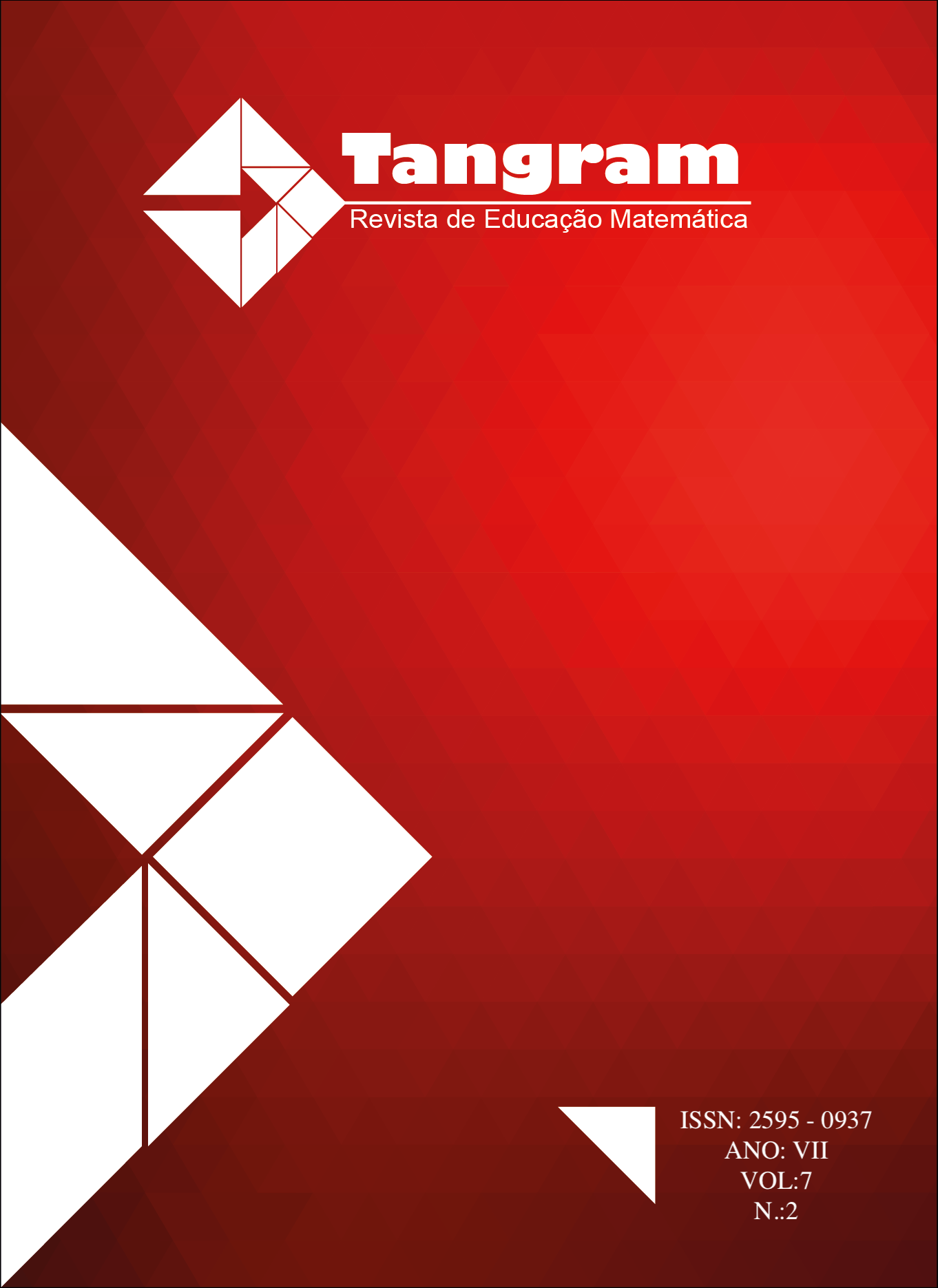PROBABILITY LEARNING IN THE 9TH GRADE OF ELEMENTARY SCHOOL THROUGH THE PRODUCTION OF DIGITAL MEDIA
DOI:
https://doi.org/10.30612/tangram.v7i2.17525Keywords:
Education. Geometry. Experience report.Abstract
The proposal and the results of the qualitative case study research, which investigated the contributions of the inverted classroom to the learning of the concepts of validated probability in an experiment conducted with students of the 9th grade of elementary school, are presented. It was considered that the learning process through the creation of didactic animations and comic books, referred to as digital cartoons, would represent a methodological approach. This approach would create a didactic situation in which students would play a central role in their own learning, because they would need to appropriate the concepts of the proposed theme, to produce a narrative that presented a problem and its solution in the form of a digital media. The results indicate that producing digital cartoons serves as a valuable resource in Mathematics Education, fostering interest in the subject and promoting activity development. It was observed that students conducted research and enhanced their understanding of Probability while working on their digital cartoons. The proposed activity can be categorized as an active methodology, embodying the principles of an inverted classroom, where students take on a central role in their learning, because they researched the theme autonomously, studied several problems of counting and probability adapting them to their language. The teacher acted as mediator, validating the proposed problems as well as their resolution. The works presented by the groups were discussed in the classroom bringing a diversity of problem situations that enhanced the learning process of the subject of Probability.
Downloads
References
Berbel, N. A. (2011). As Metodologias Ativas e a promoção da autonomia de estudantes. Semina: Ciências Sociais e Humanas, 32, 25-40.
Bergmann, J.; Sams, A. (2016). Sala de aula invertida: uma metodologia ativa de aprendizagem. (1 ed.). Rio de Janeiro: LTC.
BRASIL. MEC/INEP. (2017). Relatório do Sistema Nacional de Avaliação da Educação Básica (SAEB). Brasília: Inep. Recuperado de Saeb — Inep (www.gov.br)
Bogdan, R.C; Biklen, S. K. (1994). Investigação qualitativa em educação. Porto: Porto Editora.
Cândido, S. da S. (2012). O uso de Histórias em Quadrinhos (HQs) como ferramenta para o ensino reflexivo de Língua Portuguesa no Ensino Fundamental II. Anais Eletrônicos III Encontro Interdisciplinar de Língua Portuguesa e Literatura – ENILL, 3, Itabaiana, SE.
Cordeiro, N. J. N.; Cardozo, D. A.; Silva, M. N. (2018). Histórias em quadrinhos: algumas conexões com a Matemática. Revista Educação Matemática em Foco, 7(3). Recuperado de http://revista.uepb.edu.br/index.php/REVEDMAT/article/view/4540/3087
Costa, R. F. (2017). Aprendizagem da Matemática com cartoons: qual o papel das tecnologias digitais?. (Dissertação de Mestrado). Unemat, Barra do Bugres.
Creswell, J. W. (2014). Investigação qualitativa e projeto de pesquisa: Escolhendo entre cinco abordagens. Trad. Sandra Mallmann da Rosa. (3. ed.). Porto Alegre: Penso.
D’Ambrósio, U. (2010). Educação Matemática: Da teoria à prática. (16. ed.). São Paulo: Papirus.
Homa, A. I. R. (2020). As dificuldades em álgebra dos estudantes de engenharia: um experimento com Avaliação Diagnóstica Auxiliada Por Computador. Revista Acta Scientiae, 22(5), 254-272.
Junior, F. de P. S. de A.; Trindade, A. K. B. da; Oliveira, L. J. do N. (2019). Histórias em quadrinhos como ferramenta de contextualização de conceitos matemáticos. Revista Ensino de Matemática em Debate, 6(1). Recuperado de https://revistas.pucsp.br/index.php/emd/article/view/39239
Lüdke, M.; A., André, E. D. M. (1986). Pesquisa em educação: abordagens qualitativas. São Paulo: EPU.
Moran, J. M. (2015). Mudando a educação com Metodologias Ativas. Coleção Mídias Contemporâneas. Convergência Midiáticas, Educação e Cidadania: aproximações jovens. II, 15-33. Recuperado de http://www2.eca.usp.br/moran/wpcontent/uploads/2013/12/mudando_moran.pdf
Pereira, A. C. C. (2015) A utilização de quadrinhos no ensino da Matemática. In: Pereira, A. C. C. (Org.). Educação Matemática no Ceará: os caminhos trilhados e as perspectivas. Fortaleza: EdUECE, 31-43.
Ribeiro, F. J. (2019). Quimitoon: Química-com-Cartoons. Dissertação (Dissertação de Mestrado) Unemat, Barra do Bugres.
Sandri, D.C et al. (2018). Cartoons no ensino de Matemática. CoInspiração-Revista dos Professores que Ensinam Matemática, 1(2), 196-206.
Souza, P. H. F.; Souto, D. L. P. (2016). Luz, câmera: Educação Matemática em animação.
Silva, P. O. (2019). Contradições Internas no curso Lic-Toon: Produção de Cartoons Digitais na Formação Inicial de Matemática. (Dissertação de Mestrado) Unemat, Barra do Bugres.
Yin, R. K. (2005). Estudo de Casos: Planejamento e Métodos. São Paulo: Editora Bookman.
Downloads
Published
How to Cite
Issue
Section
License

This work is licensed under a Creative Commons Attribution-NonCommercial-ShareAlike 3.0 Unported License.
Authors must accept the publication rules when submitting the journal, as well as agree to the following terms:
(a) The Editorial Board reserves the right to make changes to the Portuguese language in the originals to maintain the cultured standard of the language, while respecting the style of the authors.
(b) Authors retain the copyright and grant the journal the right to first publication, with the work simultaneously licensed under the Attribution-NonCommercial-ShareAlike 3.0 Brazil (CC BY-NC-SA 3.0 BR) that allows: Share - copy and redistribute the material in any medium or format and Adapt - remix, transform, and create from the material. CC BY-NC-SA 3.0 BR considers the following terms:
- Attribution - You must give the appropriate credit, provide a link to the license and indicate whether changes have been made. You must do so under any reasonable circumstances, but in no way that would suggest that the licensor supports you or your use.
- NonCommercial - You may not use the material for commercial purposes.
- Sharing - If you remix, transform, or create from material, you must distribute your contributions under the same license as the original.
- No additional restrictions - You may not apply legal terms or technological measures that legally restrict others from doing anything that the license permits.
(c) After publication, authors are allowed and encouraged to publish and distribute their work online - in institutional repositories, personal page, social network or other scientific dissemination sites, as long as the publication is not for commercial purposes.






